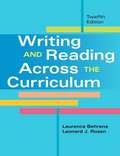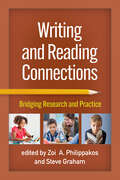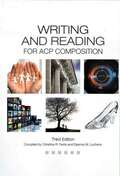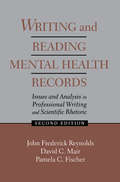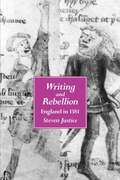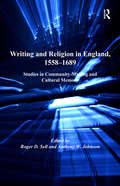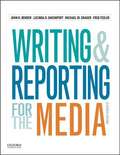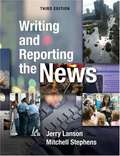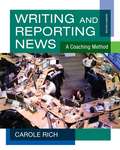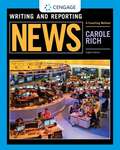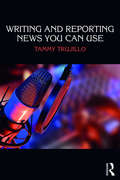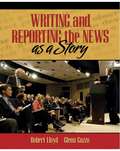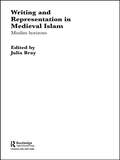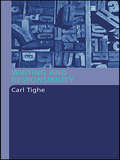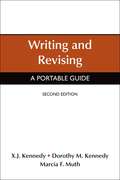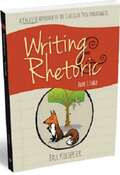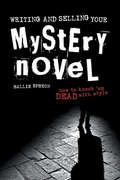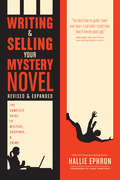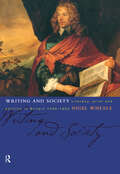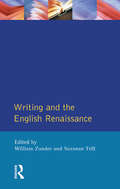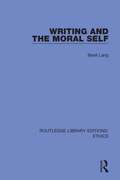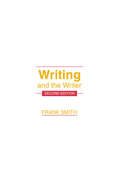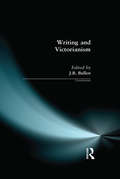- Table View
- List View
Writing and Reading Across the Curriculum (Twelfth Edition)
by Laurence Behrens Leonard J. RosenRemaining one of the best-selling interdisciplinary composition texts for over twenty-five years, Writing and Reading Across the Curriculum helps readers learn to write effectively for college.
Writing and Reading Connections: Bridging Research and Practice
by Zoi A. Philippakos Steve GrahamWriting skills are essential for success in the 21st-century school and workplace, but most classrooms devote far more time to reading instruction, with writing often addressed in isolation or excluded. In this insightful professional development resource and text, leading researchers discuss why and how to integrate writing and reading instruction in grades K–12 and beyond. Contributors explore how to harness writing–reading connections to support learning in such areas as phonics and spelling, vocabulary, understanding genre and text structure, and self-regulated strategy development, as well as across content areas and disciplines. Special considerations in teaching emergent bilingual students and struggling literacy learners are described. User-friendly features include guiding questions, classroom examples, and action questions that help teachers translate the research and concepts into practice.
Writing and Reading Mental Health Records: Issues and Analysis in Professional Writing and Scientific Rhetoric
by J. Frederick Reynolds David C. Mair Pamela C. FischerThis revised and updated second edition is a rhetorical analysis of written communication in the mental health community. As such, it contributes to the growing body of research being done in rhetoric and composition studies on the nature of writing and reading in highly specialized professional discourse communities. Many compelling questions answered in this volume include: * What "ideological biases" are reflected in the language the nurse/rhetorician uses to talk to and talk about the patient? * How does language figure into the process of constructing meaning in this context? * What social interactions -- with the patient, with other nurses, with physicians -- influence the nurse's attempt to construct meaning in this context? * How do the readers of assessment construct their own meanings of the assessment? Based on an ongoing collaboration between composition studies specialists and mental health practitioners, this book presents research of value not only to writing scholars and teachers, but also to professional clinicians, their teachers, and those who read mental health records in order to make critically important decisions. It can also be valuable as a model for other scholars to follow when conducting similar long-range studies of other writing-intensive professions.
Writing and Rebellion: England in 1381 (The New Historicism: Studies in Cultural Poetics #27)
by Steven JusticeIn this compelling account of the "peasants' revolt" of 1381, in which rebels burned hundreds of official archives and attacked other symbols of authority, Steven Justice demonstrates that the rebellion was not an uncontrolled, inarticulate explosion of peasant resentment but an informed and tactical claim to literacy and rule.Focusing on six brief, enigmatic texts written by the rebels themselves, Justice places the English peasantry within a public discourse from which historians, both medieval and modern, have thus far excluded them. He recreates the imaginative world of medieval villagers—how they worked and governed themselves, how they used official communications in unofficial ways, and how they produced a disciplined insurgent ideology.
Writing and Religion in England, 1558-1689: Studies in Community-Making and Cultural Memory
by Anthony W. JohnsonThe fruit of intensive collaboration among leading international specialists on the literature, religion and culture of early modern England, this volume examines the relationship between writing and religion in England from 1558, the year of the Elizabethan Settlement, up until the Act of Toleration of 1689. Throughout these studies, religious writing is broadly taken as being 'communicational' in the etymological sense: that is, as a medium which played a significant role in the creation or consolidation of communities. Some texts shaped or reinforced one particular kind of religious identity, whereas others fostered communities which cut across the religious borderlines which prevailed in other areas of social interaction. For a number of the scholars writing here, such communal differences correlate with different ways of drawing on the resources of cultural memory. The denominational spectrum covered ranges from several varieties of Dissent, through via media Anglicanism, to Laudianism and Roman Catholicism, and there are also glances towards heresy and the mid-seventeenth century's new atheism. With respect to the range of different genres examined, the volume spans the gamut from poetry, fictional prose, drama, court masque, sermons, devotional works, theological treatises, confessions of faith, church constitutions, tracts, and letters, to history-writing and translation. Arranged in roughly chronological order, Writing and Religion in England, 1558-1689 presents chapters which explore religious writing within the wider contexts of culture, ideas, attitudes, and law, as well as studies which concentrate more on the texts and readerships of particular writers. Several contributors embrace an inter-arts orientation, relating writing to liturgical ceremony, painting, music and architecture, while others opt for a stronger sociological slant, explicitly emphasizing the role of women writers and of writers from different sub-cultural backgrounds.
Writing and Reporting for the Media, Eleventh Edition
by John R. Bender Lucinda D. Davenport Michael W. Drager Fred FedlerA fundamental introduction to news writing and reporting, this classic text focuses on the basics of reporting, including critical thinking, thorough reporting, excellent writing and creative visual communication skills for stories across all media, and continues to be a top resource for journalism courses.
Writing And Reporting The News
by Jerry Lanson Mitchell StephensWriting and Reporting the News, Third Edition, is a comprehensive and accessible introductory text for journalism students. Jerry Lanson and Mitchell Stephens provide thorough instruction on writing and reporting, hundreds of examples of good and bad writing and extensive opportunities to apply their advice through practical exercises. Based on the authors' careers as journalists and journalism professors--and on the experience of dozens of other first-rate reporters--this unique textbook/workbook gives students a clear, logical introduction to the craft of journalism. <p><p> Discussions and examples have been updated throughout for this new edition. A new section covers writing for the Internet, the authors have added boxed sections in which reporters offer tips on how to cover specific types of stories and beats, and the Instructor's Manual to accompany the book is now available on the companion website.
Writing And Reporting News: A Coaching Method
by Carole RichPrepare yourself for the changing world of journalism with WRITING AND REPORTING NEWS: A COACHING METHOD, the book that integrates new trends in the convergence of print, broadcast and online media while teaching fundamental skills. With new information about social media, mobile media, blogs, and new skills you'll need for whatever career you choose, the seventh edition features tips, techniques, and real-life stories from writing coaches and award-winning journalists. A strong storytelling approach makes the text accessible and interesting, helping you easily master the writing and reporting techniques you'll need for media careers now and in the future.
Writing and Reporting News: A Coaching Method
by Carole RichPulling examples straight from recent headlines, WRITING AND REPORTING NEWS: A COACHING METHOD, 8e uses tips and techniques from revered writing coaches and award-winning journalists to help you develop the writing and reporting skills you need to succeed in the changing world of journalism. Full-color photographs and a strong storytelling approach keep you captivated throughout the book. <P><P>An entire chapter is devoted to media ethics, while ethical dilemmas in each chapter give you practice working through ethical issues before you face them on the job. Offering the most up-to-date coverage available, the Eighth Edition fully integrates multimedia content into the chapters-reflecting the way the news world actually operates. It also includes an all-new book glossary featuring many of the newer terms used in Journalism. Integrating new trends in the convergence of print, broadcast, and online media, WRITING AND REPORTING NEWS equips you with the fundamental skills you need for media careers now-and in the future.
Writing and Reporting News You Can Use: News You Can Use
by Tammy TrujilloWriting and Reporting News You Can Use instructs students on how to produce news that is informative, interesting, educational, and most importantly, compelling. It addresses roadblocks to student interest in writing news, using illustrative examples and exercises to help them understand how to write news that is interesting and accurate. Trujillo’s hands-on approach is based on real-world strategies that deal with audience and market characteristics. Students are writing from the very beginning while also getting the ethical and legal grounding necessary to understand the field. This textbook is a complete resource for students learning broadcast news, including how to get a job after leaving the classroom.
Writing and Reporting the News as a Story
by Robert Lloyd Glenn GuzzoFilled with current examples and tips from Pulitzer-Prize winning professionals, Writing and Reporting News as a Story teaches modern news writing skills while providing timely advice on ethics and career advancement. As a result of the outstanding professional experience of the author team and their devotion to teaching, this new text offers practical and real guidance to readers truly interested in a future in journalism.
Writing and Representation in Medieval Islam: Muslim Horizons (Routledge Studies in Middle Eastern Literatures #11)
by Julia BrayWith contributions from specialists in different areas of classical Islamic thought, this accessible volume explores the ways in which medieval Muslims saw, interpreted and represented the world around them in their writings. Focusing mainly on the eighth to tenth centuries AD, known as the ‘formative period of Islamic thought’, the book examines historiography, literary prose and Arabic prose genres which do not fall neatly into either category. Filling a gap in the literature by providing detailed discussions of both primary texts and recent scholarship, Writing and Representation in Medieval Islam will be welcomed by students and scholars of classical Arabic literature, Islamic history and medieval history.
Writing and Responsibility
by Carl TigheIn a world where literary scandals often end up in court, the issue of responsibility in writing has never been more important. In this groundbreaking study, Carl Tighe asks the questions every writer needs to consider: *What is it that writers do? Are they responsible for all the uses to which their writing might be put? Or no more responsible than their readers?*How are a writer's responsibilities compromised or defined by commercial or political pressures, or by notions of tradition or originality?*How does a writer's audience affect their responsibilities? Are these the same for writers in all parts of the world, under all political and social systems? The first part of this book defines responsibility and looks at its relation to ideas such as power, accuracy, kitsch and political correctness. The second part examines how particular writers have dealt with these issues through a series of often-controversial case studies, including American Psycho, Crash and The Tin Drum. Writing and Responsibility encourages its readers to interrogate the choices they make as writers. A fascinating look at the public consequences of the private act of writing, Carl Tighe's book is a must-read for everyone who writes or studies writing.
Writing and Revising: A Portable Guide (Second Edition)
by Marcia F. Muth X. J. Kennedy Dorothy M. KennedyWriting and Revising can be used as a classroom text or as a quick reference, accommodating many different teaching needs. Whether students are developing brief papers or more complicated essays drawing on multiple sources, Writing and Revising encourages students, bolstering their confidence as they strengthen the skills necessary for writing projects in college and beyond.
Writing And Rhetoric Book 1: Student
by Paul KortepeterA Creative Approach to the Classical Progymnasmata- Think of the progymnasmata as a step-by-step apprenticeship in the art of writing and rhetoric. What is an apprentice? It is a young person who is learning a skill from a master teacher. Our students will serve as apprentices to the great writers and great stories of history. Students are often expected to write with no clear model before them.Modern composition scolds traditional writing instruction as rote and unimaginative.It takes imitation to task for a lack of freedom and personal expression.And yet, effective communication from writer to reader always requires some sort of form and structure.Many of historys greatest writers learned by imitation.In other words, writing takes the same kind of determined study as ballet or diving.Creativity uses conventional form as a stage or a springboard from which to launch grand jetes and somersaults. Too often students are expected to tackle complex writing assignments without learning the necessary intermediate steps.The assumption is that because most everyone can speak English well enough to be understood, and form letters with a pencil, that everyone should be able to write well.Yet how many of us would expect a child to sit at a piano, without piano lessons, and play a concerto?Writing is never automatic. The Writing & Rhetoric seriesmethod employsfluent reading, careful listening, models for imitation, and progressive steps.It assumes that students learn best by reading excellent, whole-story examples of literature and by growing their skills through imitation. Each exercise is intended to impart a skill (or tool) that can be employed in all kinds of writing and speaking.The exercises are arranged from simple to more complex. Whats more, the exercises are cumulative, meaning that later exercises incorporate the skills acquired in preceding exercises.This series is a step-by-step apprenticeship in the art of writing and rhetoric. Fable, the first book in the Writing & Rhetoric series, teaches students the practice of close reading and comprehension, summarizing a story aloud and in writing, and amplification of a story through description and dialogue.Students learn how to identify different kinds of stories;determine the beginning, middle, and end of stories;recognize point of view; and see analogous situations, among other essential tools. The Writing & Rhetoric seriesrecovers aproven method of teaching writing, using fables to teach beginning writers the craft of writing well.This is the first in a series of twelve books that will train students over six years, starting in grades three or four and up.
Writing And Selling Your Mystery Novel: How To Knock 'em Dead With Style
by Hallie EphronHallie Ephron helps beginning and experienced writers create a page-turner through her comprehensive instruction, exercises and worksheets that show how to grab the reader from the very first chapter.
Writing and Selling Your Mystery Novel Revised and Expanded Edition: The Complete Guide to Mystery, Suspense, and Crime
by Sara Paretsky Hallie EphronA Mystery Writers of America Edgar Award Finalist for Best Critical/Biographical Work Discover the secrets to crafting an unforgettable mystery! To piece together the puzzle of your mystery novel, you need patience, resilience, a solid understanding of the craft, and a clear blueprint for combining the plot, characters, setting, and more. And while patience and resilience must come from you, the essentials of craft and the plan to execute them are right at your fingertips with Writing and Selling Your Mystery Novel. This completely revised and updated edition features solid strategies for drafting, revising, and selling an intriguing novel that grips your readers and refuses to let them go.New York Times best-selling author Hallie Ephron shows you how to:Create a compelling sleuth and a worthy villainConstruct a plot rich in twists, red herrings, and misdirectionBring the story to a satisfying conclusionSharpen characters and optimize pace during revisionSeek publication through both traditional and indie pathsFilled with helpful worksheets and exercises for every step of the process, Writing and Selling Your Mystery Novel Revised and Expanded reveals the keys to writing a memorable story that will have fans of mystery, suspense, and crime clamoring for more.
Writing and Society
by Florian CoulmasHow does writing relate to speech? What impact does it have on social organisation and development? How do unwritten languages differ from those that have a written form and tradition? This book is a general account of the place of writing in society. Drawing on contemporary and historical examples, from clay tablets to touchscreen displays, the book explores the functions of writing and written language, analysing its consequences for language, society, economy and politics. It examines the social causes of illiteracy, demonstrating that institutions of central importance to modern society are built upon writing and written texts, and are characterised by specific forms of communication. It explores the social dimensions of spelling and writing reform, as well as of digital literacy, a new mode of expression and communication posing novel challenges to the student of language in society.
Writing and Society: Literacy, Print and Politics in Britain 1590-1660
by Nigel WhealeWriting and Society is a stunning exploration of the relationship between the growth in popular literacy and the development of new readerships and the authors addressing them. It is the first single volume to provide a year-by-year chronology of political events in relation to cultural production.This overview of debates in literary critical theory and historiography includes facsimile pages with commentary from the most influential books of the period. The author describes and analyses:* the development of literacy by status, gender and region in Britain* structures of patronage and censorship* the fundamental role of the publishing industry* the relation between elite literary and popular cultures* and the remarkable growth of female literacy and publication.
Writing and the Ancient State
by Wang HaichengWriting and the Ancient State explores the early development of writing and its relationship to the growth of political structures. The first part of the book focuses on the contribution of writing to the state's legitimating project. The second part deals with the state's use of writing in administration, analyzing both textual and archaeological evidence to reconstruct how the state used bookkeeping to allocate land, police its people, and extract taxes from them. The third part focuses on education, the state's system for replenishing its staff of scribe-officials. The first half of each part surveys evidence from Mesopotamia, Egypt, the Maya lowlands, Central Mexico, and the Andes; against this background the second half examines the evidence from China. The chief aim of this book is to shed new light on early China (from the second millennium BC through the end of the Han period, ca. 220 AD) while bringing to bear the lens of cross-cultural analysis on each of the civilizations under discussion. The compiling of lists - lists of names, or of names and numbers - is a recurring theme throughout all three parts. A concluding chapter argues that there is nothing accidental about the pervasiveness of this theme: in both origin and function, early writing is almost synonymous with the listing of names.
Writing and the English Renaissance (Crosscurrents)
by Suzanne Trill William ZunderWriting and the English Renaissance is a collection of essays exploring the full creative richness of Renaissance culture during the sixteenth and seventeenth centuries. As well as considering major literary figures such as Spenser, Marlowe, Donne and Milton, lesser known - especially women - writers are also examined. Radical writing and popular culture are considered as well. The scope of the study not only extends the parameters for debate in Renaissance studies, but also adopts a radical interdisciplinary approach, bridging the gap between literary, historical, cultural and women's studies, leading to a much fuller picture of life in the sixteenth and seventeenth centuries.The authors discussed are placed in their full historical and literary context, with an extensive selection of original documentation included in the text - for example, from The Book of Common Prayer or the Homilies to contextualize the writing under discussion. This distinctive approach, combined with a detailed chronology of the period and bibliography, embracing both canonical and non-canonical writers, makes this volume a unique reference resource and course reader for Renaissance studies.
Writing and the Moral Self
by Berel LangOriginally published in 1991, this book analyses the relation between writing and ethics in a number of social contexts – in politics, as language discloses its connections to the institutions of totalitarianism and democracy; in the university, as contemporary scholarly ideals find an uncomfortably accurate representation in the stylistic forms of academic writing; in daily social practice, ranging from the status of truth in journalistic writing to the connection between pronouns and affirmative action; and finally in the ethical structure of language itself.
Writing and the Writer
by Frank SmithExploring the relationship between the writer and what he/she happens to be writing, this text by one of the foremost scholars in the field of literacy and cognition is a unique and original examination of writing--as a craft and as a cognitive activity. The book is concerned with the physical activity of writing, the way the nervous system recruits the muscles to move the pen or manipulate the typewriter. It considers the necessary disciplines of writing, such as knowledge of the conventions of grammar, spelling, and punctuation. In particular, there is a concern with how the skills underlying all these aspects of writing are learned and orchestrated. This second edition includes many new insights from the author's significant experience and from recent research, providing a framework for thinking about the act of writing in both theoretical and practical ways. A completely new chapter on computers and writing is included, as well as more about the role of reading in learning to write, about learning to write at all ages, and about such controversial issues as whether and how genre theory should be taught. Written in nontechnical language, this text will continue to be accessible and stimulating to a wide range of readers concerned with writing, literacy, thinking, and education. Furthermore, it has an educational orientation, therefore proving relevant and useful to anyone who teaches about writing or endeavors to teach writing.
Writing and Victorianism (Crosscurrents)
by J. B. BullenWriting and Victorianism asks the fundamental question 'what is Victorianism?' and offers a number of answers taken from methods and approaches which have been developed over the last ten years. This collection of essays, written by both new and established scholars from Britain and the U.S.A, develops many of the themes of nineteenth-century studies which have lately come to the fore, touching upon issues such as drugs, class, power and gender. Some essays reflect the interaction of word and image in the nineteenth-century, and the notion of the city as spectacle; others look at Victorian science finding a connection between writing and the growth of psychology and psychiatry on the one hand and with the power of scientific materialism on the other.As well as key figures such as Dickens, Tennyson and Wilde, a host of new names are introduced including working-class writers attempting to define themselves and writers in the Periodical press who, once anonymous, exercised a great influence over Victorian politics, taste, and social ideals. From these observations there emerges a need for self-definition in Victorian writing. History, ancestry, and the past all play their part in figuring the present in the nineteenth-century, and many of these studies foreground the problem of literary, social, and psychological identity.
